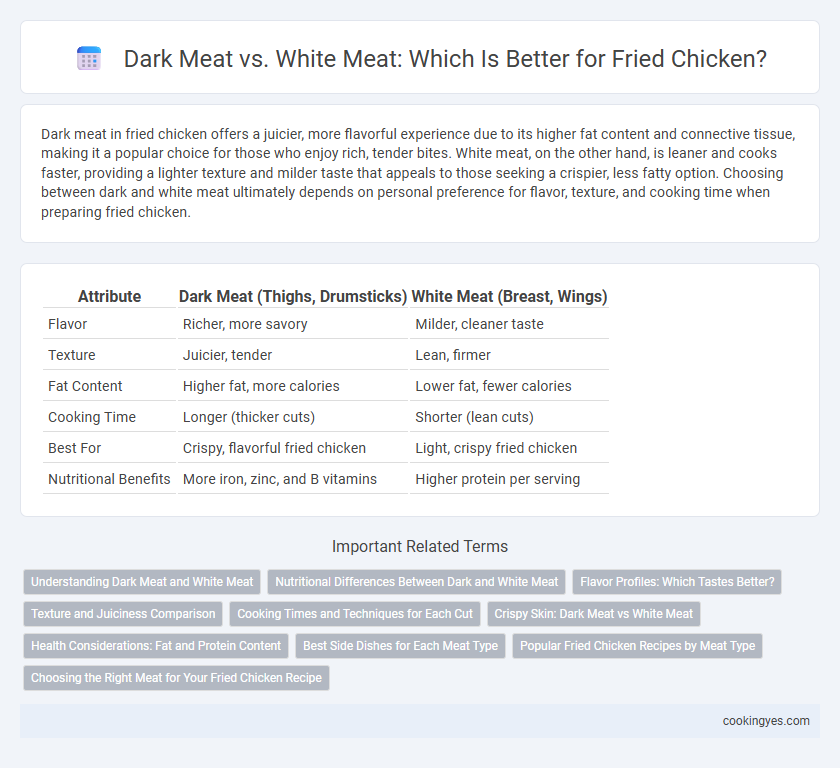Dark meat in fried chicken offers a juicier, more flavorful experience due to its higher fat content and connective tissue, making it a popular choice for those who enjoy rich, tender bites. White meat, on the other hand, is leaner and cooks faster, providing a lighter texture and milder taste that appeals to those seeking a crispier, less fatty option. Choosing between dark and white meat ultimately depends on personal preference for flavor, texture, and cooking time when preparing fried chicken.
Table of Comparison
| Attribute | Dark Meat (Thighs, Drumsticks) | White Meat (Breast, Wings) |
|---|---|---|
| Flavor | Richer, more savory | Milder, cleaner taste |
| Texture | Juicier, tender | Lean, firmer |
| Fat Content | Higher fat, more calories | Lower fat, fewer calories |
| Cooking Time | Longer (thicker cuts) | Shorter (lean cuts) |
| Best For | Crispy, flavorful fried chicken | Light, crispy fried chicken |
| Nutritional Benefits | More iron, zinc, and B vitamins | Higher protein per serving |
Understanding Dark Meat and White Meat
Dark meat in fried chicken comes from muscles that are used more frequently, such as the thighs and drumsticks, containing higher fat content and myoglobin, which gives it a richer flavor and juicier texture. White meat, primarily from the breast, has less fat and myoglobin, resulting in a leaner, milder taste and a firmer texture when fried. Understanding the differences helps in choosing the preferred balance of flavor, moisture, and nutritional content in fried chicken dishes.
Nutritional Differences Between Dark and White Meat
Dark meat in fried chicken contains higher levels of fat, iron, and zinc compared to white meat, making it richer in essential nutrients but also more calorie-dense. White meat offers a leaner option with lower fat content and fewer calories, while still providing a significant amount of protein. The choice between dark and white meat affects overall nutritional intake, particularly in terms of saturated fat and micronutrient profiles.
Flavor Profiles: Which Tastes Better?
Dark meat in fried chicken offers a richer, juicier flavor with a slightly gamey, intense taste due to higher fat content and myoglobin levels. White meat has a milder, more delicate taste and a firmer texture, often preferred for its lean qualities but can be less flavorful when fried. The preference for flavor profiles depends on individual taste buds, with dark meat favored for boldness and white meat for subtlety in fried chicken.
Texture and Juiciness Comparison
Dark meat in fried chicken offers a richer texture with a higher fat content, resulting in a juicier and more tender bite compared to white meat. White meat, such as breast, tends to be leaner and firmer, which can lead to a drier texture when fried. The moisture retention in dark meat enhances its succulence, making it the preferred choice for those seeking a flavorful and moist fried chicken experience.
Cooking Times and Techniques for Each Cut
Dark meat, such as thighs and drumsticks, requires longer cooking times due to higher fat content and connective tissues, benefiting from lower heat and longer frying to achieve tender, juicy results. White meat, like chicken breasts, cooks faster and demands careful temperature control to prevent drying out, typically fried at medium-high heat for a shorter duration. Employing a two-step frying technique--initial low-temperature cooking followed by a high-temperature crisping--ensures optimal texture for both dark and white meat cuts.
Crispy Skin: Dark Meat vs White Meat
Dark meat chicken, typically from the thigh and drumstick, retains more fat and moisture, contributing to a juicier interior while still developing a crispy skin during frying. White meat, from the breast and wing, cooks faster and can achieve a lighter, crisper skin but risks drying out if overcooked. Optimal fried chicken balances dark meat's richness with white meat's crispiness to enhance both texture and flavor.
Health Considerations: Fat and Protein Content
Dark meat in fried chicken contains higher fat content and more calories than white meat, making it richer but less suitable for low-fat diets. White meat provides a leaner protein source with lower saturated fat, benefiting those focused on heart health and muscle maintenance. Choosing between dark and white meat depends on balancing flavor preferences with dietary goals related to fat intake and protein needs.
Best Side Dishes for Each Meat Type
Dark meat fried chicken, rich in flavor and juiciness, pairs excellently with bold side dishes like creamy mashed potatoes, collard greens, and cornbread, which complement its robust taste. White meat fried chicken, tender and mild, is best balanced with lighter sides such as coleslaw, steamed vegetables, and rice pilaf to enhance its delicate texture. Choosing sides that match the intensity of the meat optimizes the overall dining experience and flavor harmony.
Popular Fried Chicken Recipes by Meat Type
Dark meat is prized for its rich flavor and juiciness, making it ideal for traditional Southern fried chicken recipes that emphasize crispy, flavorful crusts. White meat, especially chicken breast, is favored in lighter, crispy fried chicken variants like Nashville hot chicken and buttermilk battered recipes due to its lean texture and quick cooking time. Popular fried chicken recipes often balance dark and white meat to offer both succulence and crunch, catering to diverse taste preferences.
Choosing the Right Meat for Your Fried Chicken Recipe
Dark meat offers a juicier, more flavorful option for fried chicken due to its higher fat content and connective tissues, making it ideal for recipes seeking rich taste and tenderness. White meat, found in the breast, provides a leaner alternative with a mild flavor and firmer texture, perfect for crisp, lighter fried chicken. Selecting between dark and white meat depends on desired flavor intensity, moisture retention, and cooking time preferences in your fried chicken recipe.
Dark Meat vs White Meat for Fried Chicken Infographic

 cookingyes.com
cookingyes.com